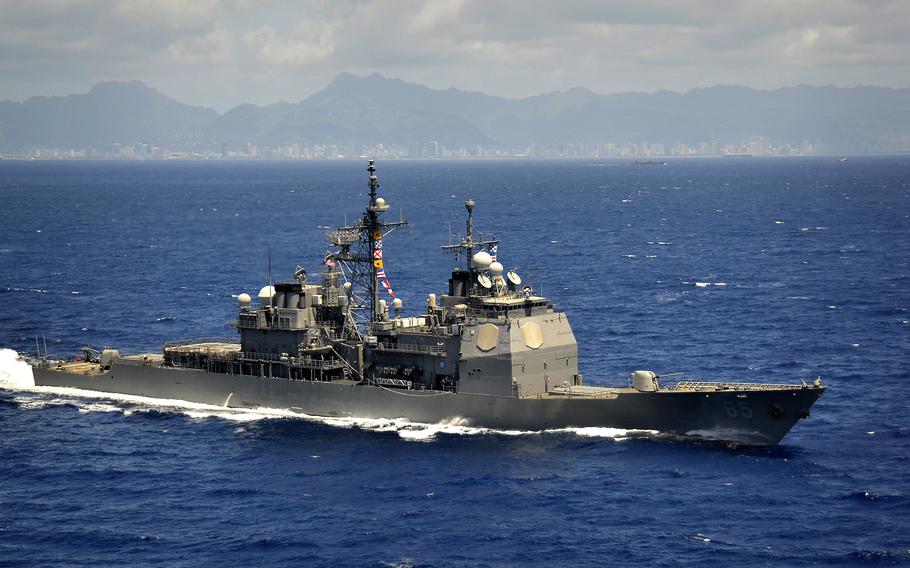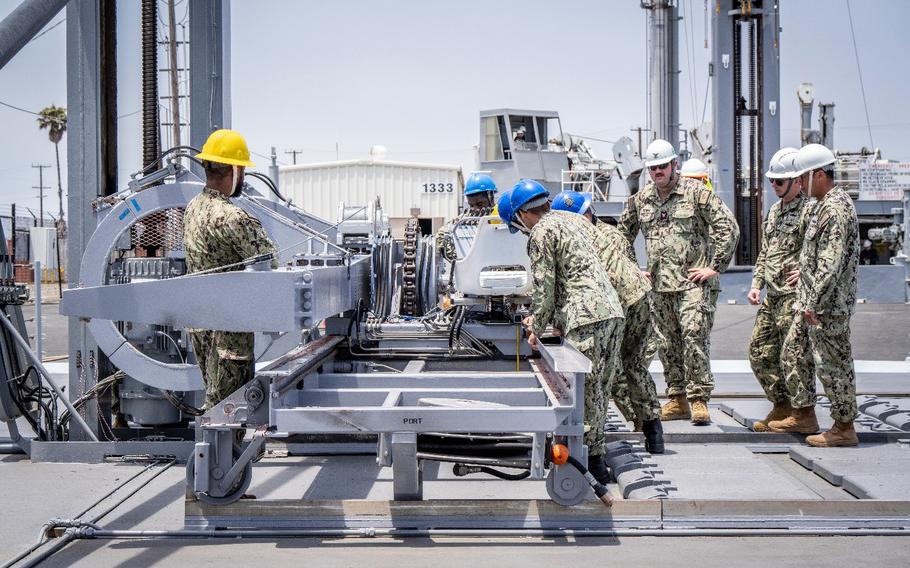
The Ticonderoga-class, guided-missile cruiser USS Chosin conducts exercises off the coast of Hawaii. (U.S. Navy)
The Navy’s first-ever attempt to resupply a warship’s weapons system at sea was successful, service officials announced Friday.
Sailors aboard the cruiser USS Chosin used the hydraulically powered Transferrable Rearming Mechanism, or TRAM, to load an empty missile canister into the ship’s vertical launching system Friday while 30 miles off the coast of San Diego, Navy officials said. The developing technology will enable Navy destroyers and cruisers to reload rapid-fire missiles into the vertical launch system while at sea — a task that now must be done pier side.
“TRAM offers us a powerful near-term deterrent that will disrupt the strategic calculus of those who would do us harm around the globe,” Navy Secretary Carlos Del Toro said during a news conference in San Diego following the at-sea demonstration.
The technology is on track to be fielded in two to three years — an unprecedented delivery speed, according to the Naval Sea Systems Command. In fiscal 2023, the service allocated $3.9 million in research, test, development and evaluation funds with another $12.4 million dedicated to the program in fiscal 2024.
At-sea rearming has been intermittently tested by the U.S. over the years but became a top priority for Del Toro in 2022, as the threat of conflict with China loomed. The rearming mechanism uses a crane that can lift and rotate 25-foot missile canisters vertically, then lowers the explosives into the launchers, which are small openings in the ship deck.
For the at-sea test, the Chosin connected to USNS Washington Chambers, a dry cargo and ammunition ship, which transferred the missile canister across cables to the cruiser. The sailors then used TRAM to move the missile canister along rails attached to the cruiser’s launch system modules, tilt it into a vertical position, and lower it into a system cell with TRAM’s built-in cable and pulley system.
At times during the demonstration, Del Toro said, the crews were operating in a sea state 4. A sea state 4 means winds of 11-16 knots and 3 to 5-foot waves, according to the Beaufort Scale, a measure that estimates wind speed and its effects based on observed sea or land conditions.
Engineers at the Naval Surface Warfare Center in Port Hueneme, Calif., developed the TRAM prototype to rearm warships during the underway replenishment process — when a supply ship connects to a combatant at sea to transfer material such as fuel and food. The system is designed to reload vertical launch systems on surface ships in sea states 3 or higher. A sea state 3 means winds of 7-10 knots and 2-foot waves, according to the Beaufort Scale.

Sailors from the Navy Expeditionary Logistics Support Group and USS Chosin prepare to operate the Navy’s Transferrable Rearming Mechanism as they demonstrate reloading a vertical launching system cell on July 10, 2024, at the Naval Surface Warfare Center, Port Hueneme, Calif. (Craig Weiman/Johns Hopkins University)
Operationally, reloading in the open ocean would allow the U.S. surface fleet to stay in a fight, rather than leaving to reload at a friendly port. A report released in January 2023 by the Washington think tank Center for Strategic and International Studies estimated in a conflict over Taiwan, the U.S. could run out of several types of munitions — such as long-range, anti-ship missiles — in less than a week. A 2019 study by the Center for Strategic and Budgetary Assessments, another Washington think tank, estimated in a conflict with China, the Navy could expend more than 360 missiles a day, or 10,800 per month. U.S. warships would have to make multiple trips to rearm. For the Pacific fleet, these reload sites are in Japan, Guam, Hawaii and California and would mean leaving a battle for weeks at a time.
“The combatant can stay near the fight to be rearmed, refueled and resupplied all at the same time,” said Rich Hadley, the underway replenishment division manager at the warfare center. “As Capt. Arleigh Burke said, ‘All time spent in replenishing was time lost in combat.’ TRAM improves operational effectives by reducing the amount of time the warfighter must spend away from the fight replenishing.”
The at-sea test follows the first successful land-based demonstration conducted in July by the warfare center.
Del Toro said the next step is to begin scheduling destroyers and other cruisers to practice using the TRAM at sea. He hopes to see it widely used throughout the fleet by 2030.
“The future is really promising, and I think we are going to get there faster than we think,” Del Toro said.